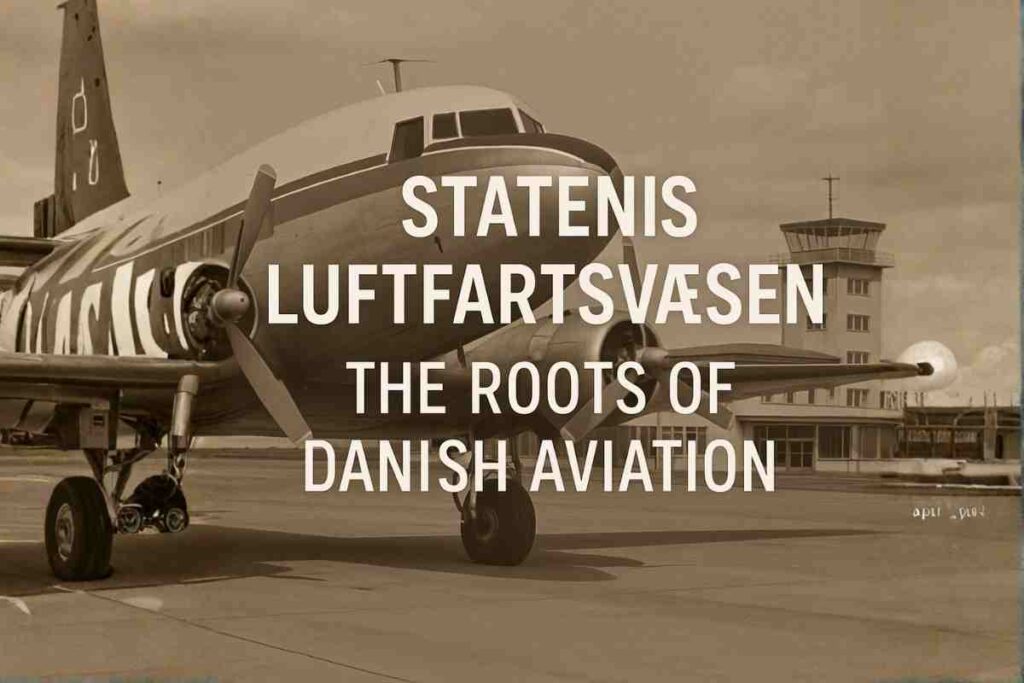Statens Luftfartsvæsen, often called SLV, was Denmark’s civil aviation authority for decades. It oversaw air safety, pilot licensing, airport standards, and aircraft certification. Beyond Denmark, it played a key role in Greenland and the Faroe Islands, where challenging climates demanded specialized aviation solutions.
Although its responsibilities were later transferred to Trafikstyrelsen and Naviair, the foundation built by Statens Luftfartsvæsen still shapes Danish and international aviation today.
The Origins of Statens Luftfartsvæsen
SLV was founded in 1925, during a time when aviation in Europe was shifting from military operations to commercial passenger travel and cargo. Denmark needed an organization to regulate this fast growing industry and ensure safety in the skies.
From the very beginning, SLV was not only a national regulator but also an active voice in shaping global aviation policy. Based on historical records, its early work laid the groundwork for safer skies across Northern Europe.
Core Responsibilities and Functions
Airspace Regulation and Traffic Management
SLV managed Danish airspace, balancing civil and military use. Using radar, satellite navigation, and later digital systems, it improved routing efficiency and fuel savings. It also had responsibility for North Atlantic and Arctic airspace, making Denmark an important hub for transatlantic flights.
Aircraft Certification and Safety Oversight
Every aircraft in Denmark had to meet strict technical standards. SLV handled type certification, registration, and regular inspections. Many users report that its safety oversight helped Denmark earn a strong reputation for reliable and airworthy fleets.
Pilot Licensing and Training Standards
The authority was responsible for pilot licensing, following guidelines from ICAO and later EASA. This included approving flight schools, conducting exams, and monitoring medical standards. A reliable method was ensuring pilots met both theoretical and practical requirements before flying commercial routes.
Airport Certification and Infrastructure Oversight
SLV supervised airport licensing, safety checks, and emergency response systems. Airports like Copenhagen Kastrup and Aalborg benefited from these standards, which helped them grow into international hubs. Environmental reviews also became part of its regulatory process, especially as noise and emissions became public concerns.
Environmental and Safety Policies
Based on industry updates from the 1980s and 1990s, SLV was among the early regulators to focus on reducing aircraft noise near cities. It also introduced sustainability programs, emission monitoring, and early studies into alternative aviation fuels.
Major Contributions to Danish and Global Aviation
Key Milestones in SLV’s Development
- 1950s – Joined ICAO, strengthening Denmark’s role in global aviation policy.
- 1970s – Expanded air traffic coverage across Greenland and North Atlantic routes.
- 1990s – Adopted EU directives and aligned with EASA safety standards.
- 2005 – Transitioned many responsibilities to Trafikstyrelsen and Naviair.
Support for Greenland and the Faroe Islands
SLV supported aviation in remote areas where weather and geography created unique challenges. It developed safe airstrips, reliable helicopter networks, and weather monitoring systems to connect communities. Many users report that this work was vital for medical flights, cargo deliveries, and emergency transport.
International Collaboration
SLV worked closely with ICAO, Eurocontrol, and Nordic aviation forums. It helped harmonize safety policies across Europe and contributed to climate-focused aviation initiatives.
Transition to Trafikstyrelsen and Naviair
In 2005, the Danish government reorganized aviation oversight.
- Trafikstyrelsen (Danish Transport Authority) took over responsibilities for licensing, certification, and regulation.
- Naviair, a state owned company, assumed responsibility for air traffic management and navigation services.
This transition allowed Trafikstyrelsen to focus on regulatory tasks while Naviair concentrated on safe and efficient air navigation. Many industry experts note that this split improved efficiency and specialization.
Legacy and Continued Influence of SLV
Even though Statens Luftfartsvæsen no longer exists as an independent body, its influence remains visible.
- Safety protocols introduced by SLV are still in use.
- Air navigation systems developed under its oversight continue to guide flights today.
- Its early work on sustainability shaped modern climate policies in aviation.
- Denmark’s reputation for reliable aviation management is directly tied to SLV’s standards.
For travelers and professionals alike, the safety first culture built by SLV ensures confidence in Danish aviation to this day.
Statens Luftfartsvæsen and the Future of Danish Aviation
The work started by SLV continues under Trafikstyrelsen and Naviair, with a stronger focus on innovation.
- Sustainability: Denmark is investing in hydrogen-powered and electric aviation research, building on SLV’s early environmental programs.
- Digital Innovation: Next-gen technologies such as ADS-B and CPDLC are being expanded to improve efficiency and reduce emissions.
- Global Partnerships: Denmark remains a key voice in international aviation forums, reflecting the legacy of SLV’s collaboration with global regulators.
Based on industry updates, future growth in Danish aviation will rely on balancing safety, sustainability, and efficiency values that trace back to Statens Luftfartsvæsen.
Conclusion: Why SLV Still Matters
Statens Luftfartsvæsen was more than a regulator. It was the foundation of Denmark’s aviation safety and international influence. From airspace management to pilot training, SLV shaped every aspect of flying in Denmark and beyond.
Its systems, policies, and culture of accountability continue to guide Trafikstyrelsen and Naviair. While the organization itself no longer exists, its legacy remains the backbone of Danish aviation.
FAQs
What was Statens Luftfartsvæsen responsible for?
It was responsible for regulating Danish aviation, including airspace management, pilot licensing, aircraft certification, airport oversight, and aviation safety programs. It also supported Greenland and the Faroe Islands with specialized aviation policies.
Who regulates Danish aviation today?
After 2005, Trafikstyrelsen (Danish Transport Authority) became the main regulator, while Naviair took over air navigation services. Together, they manage licensing, certification, safety oversight, and real-time traffic management.
What is the difference between Trafikstyrelsen and Naviair?
Trafikstyrelsen handles regulatory tasks such as pilot licensing, aircraft certification, and safety inspections. Naviair focuses on operational air navigation services, ensuring aircraft move safely and efficiently in Danish and North Atlantic airspace.
When was Statens Luftfartsvæsen established?
It was established in 1925, making it one of Europe’s earliest civil aviation authorities. Its creation marked the transition from military dominated aviation to commercial passenger and cargo air travel.
How did Statens Luftfartsvæsen improve aviation safety?
SLV introduced strict certification standards, real-time radar surveillance, safety management systems, and accident investigation procedures. These measures made Danish aviation safer and helped align the country with international best practices.





